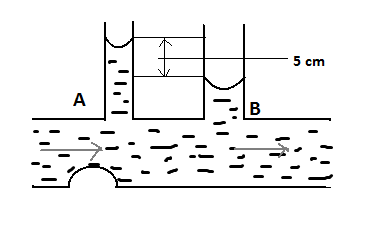Answer
76.2k+ views
Hint: This problem uses Bernoulli's theorem. Bernoulli's theorem is the pressure version of energy conservation. It is also similar to conservation of momentum.
Complete solution:
Bernoulli’s principle: In fluid dynamics, Bernoulli's principle states that an increase in the speed of a fluid occurs simultaneously with a decrease in static pressure or a decrease in the fluid's potential energy. Bernoulli's principle can be applied to various types of fluid flow, resulting in various forms of Bernoulli's equation; there are different forms of Bernoulli's equation for different types of flow.
The simplest one being;
$P + \dfrac{1}{2}\rho {v^2} = C$.
Here, $P$ is the pressure at the surface of the liquid due to air, $\rho $ is the density of the fluid and v is the velocity of the fluid and C is constant.
Bernoulli's theorem also describes the relationship between a fluid's velocity and cross-sectional area. Mathematically it is written as ${A_1}{v_1} = {A_2}{v_2}$.
Now in this case, the difference between the tubes is given viz. 5cm= 0.05 meters.
So first we find the velocity relation in the two tubes.
Hence by applying Bernoulli’s theorem we get;
${A_1}{v_1} = {A_2}{v_2}$ here, ${A_1} = 6m{m^2}$ and ${A_2} = 10m{m^2}$ ;
Thus, $6{v_1} = 10{v_2}$
Thus ${v_1} = \dfrac{5}{3}{v_2}$ (equation:1)
Now apply Bernoulli’s theorem of conservation of pressure;
${P_1} + \dfrac{1}{2}\rho {v_1}^2 = {P_2} + \dfrac{1}{2}\rho {v_2}^2$
Solving the equation further we get;
${P_1} - {P_2} = \dfrac{1}{2}\rho \left( {{v_2}^2 - {v_1}^2} \right)$
${P_1} - {P_2} = \dfrac{1}{2}\rho \left( {{v_2}^2 - \dfrac{{25}}{9}{v_2}^2} \right)$ (from equation: 1)
Now we know that, ${P_2} - {P _1} = \rho g({h_2} - {h_1}) = 0.05\rho g$ (given)
$0.05\rho g = \dfrac{1}{2}\rho \left( {\dfrac{{16}}{9}{v_2}^2} \right)$
Solving the above equation we get,
${v_2} = 0.75m{s^{ - 2}}$
Therefore, rate of flow is mathematically Area X velocity;
Rate=${A_2}{v_2} = 75 \times {10^{ - 1}}c{m^3}{\sec ^{ - 1}}$
Hence option A is correct.
Note: (1) The units must be converted very carefully
(2) Av is the rate of flow of fluid so Bernoulli’s principle states that rate of flow is constant.
Complete solution:
Bernoulli’s principle: In fluid dynamics, Bernoulli's principle states that an increase in the speed of a fluid occurs simultaneously with a decrease in static pressure or a decrease in the fluid's potential energy. Bernoulli's principle can be applied to various types of fluid flow, resulting in various forms of Bernoulli's equation; there are different forms of Bernoulli's equation for different types of flow.
The simplest one being;
$P + \dfrac{1}{2}\rho {v^2} = C$.
Here, $P$ is the pressure at the surface of the liquid due to air, $\rho $ is the density of the fluid and v is the velocity of the fluid and C is constant.
Bernoulli's theorem also describes the relationship between a fluid's velocity and cross-sectional area. Mathematically it is written as ${A_1}{v_1} = {A_2}{v_2}$.
Now in this case, the difference between the tubes is given viz. 5cm= 0.05 meters.
So first we find the velocity relation in the two tubes.
Hence by applying Bernoulli’s theorem we get;
${A_1}{v_1} = {A_2}{v_2}$ here, ${A_1} = 6m{m^2}$ and ${A_2} = 10m{m^2}$ ;
Thus, $6{v_1} = 10{v_2}$
Thus ${v_1} = \dfrac{5}{3}{v_2}$ (equation:1)
Now apply Bernoulli’s theorem of conservation of pressure;
${P_1} + \dfrac{1}{2}\rho {v_1}^2 = {P_2} + \dfrac{1}{2}\rho {v_2}^2$
Solving the equation further we get;
${P_1} - {P_2} = \dfrac{1}{2}\rho \left( {{v_2}^2 - {v_1}^2} \right)$
${P_1} - {P_2} = \dfrac{1}{2}\rho \left( {{v_2}^2 - \dfrac{{25}}{9}{v_2}^2} \right)$ (from equation: 1)
Now we know that, ${P_2} - {P _1} = \rho g({h_2} - {h_1}) = 0.05\rho g$ (given)
$0.05\rho g = \dfrac{1}{2}\rho \left( {\dfrac{{16}}{9}{v_2}^2} \right)$
Solving the above equation we get,
${v_2} = 0.75m{s^{ - 2}}$
Therefore, rate of flow is mathematically Area X velocity;
Rate=${A_2}{v_2} = 75 \times {10^{ - 1}}c{m^3}{\sec ^{ - 1}}$
Hence option A is correct.
Note: (1) The units must be converted very carefully
(2) Av is the rate of flow of fluid so Bernoulli’s principle states that rate of flow is constant.
Recently Updated Pages
Write an article on the need and importance of sports class 10 english JEE_Main

Choose the exact meaning of the given idiomphrase The class 9 english JEE_Main

Choose the one which best expresses the meaning of class 9 english JEE_Main

What does a hydrometer consist of A A cylindrical stem class 9 physics JEE_Main

A motorcyclist of mass m is to negotiate a curve of class 9 physics JEE_Main

A man stands at a distance of 250m from a wall He shoots class 9 physics JEE_Main




